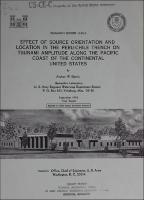Please use this identifier to cite or link to this item:
https://hdl.handle.net/11681/3262| Title: | Effect of source orientation and location in the Peru-Chile Trench on tsunami amplitude along the Pacific Coast of the Continental United States |
| Authors: | Garcia, Andrew W. |
| Keywords: | Finite difference method Pacific Coast (America) Peru-Chile Trench Tsunamis Numerical models Mathematical models |
| Publisher: | Hydraulics Laboratory (U.S.) Engineer Research and Development Center (U.S.) |
| Series/Report no.: | Research report (U.S. Army Engineer Waterways Experiment Station) ; H-76-2. |
| Description: | Research Report Abstract: An idealized axis of the Peru-Chile Trench was divided into 12 segments of equal length. A hypothetical bottom displacement which generates a tsunami with intensity approximately equal to four was centered in three of the segments. An explicit finite difference numerical code was used to simulate generation and propagation of the resulting tsunami to the west coast of the continental United States. Additionally, the tsunami of 22 May 1960 was simulated and comparison made to gage records at selected open coast locations along the U. S. Pacific coast. Contour plots of surface elevation of the few leading waves of the tsunami at selected times are presented. An analytical technique is used to normalize the amplitude of the leading wave of the tsunami to its amplitude at 600-ft water depth. For purposes of comparison, the amplitudes of the tsunamis generated in each segment are plotted as a function of distance along the Pacific coast from the Mexican to the Canadian border. These plots allow an evaluation of the relative vulnerability of coastal locations to tsunamis generated in different locations of the Peru-Chile Trench. |
| Rights: | Approved for public release; distribution is unlimited. |
| URI: | http://hdl.handle.net/11681/3262 |
| Appears in Collections: | Research Report |
Files in This Item:
| File | Description | Size | Format | |
|---|---|---|---|---|
| RR-H-76-2.pdf | 7.51 MB | Adobe PDF |  View/Open |